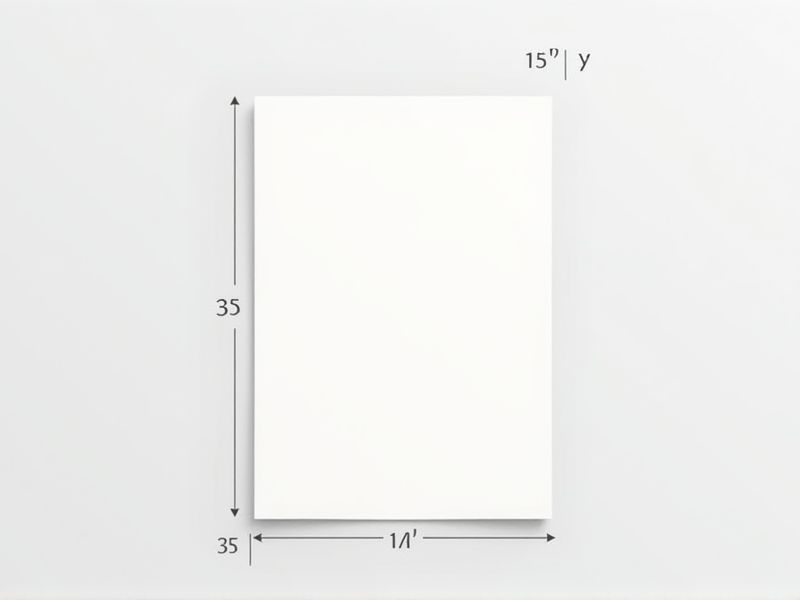
The standard dimensions of a piece of paper can vary depending on the region and type of paper, but the most commonly used size worldwide is A4, which measures 210 mm by 297 mm (8.27 inches by 11.69 inches). In the United States and Canada, the typical letter size paper measures 8.5 inches by 11 inches (216 mm by 279 mm). It's helpful to know these sizes for printing, copying, or sharing documents, as using the correct dimensions ensures compatibility across devices and organizations. When purchasing paper or setting up a printer, be sure to select the appropriate standard size for your specific needs.
A4 Size
A4 paper measures 210 x 297 millimeters, making it the most widely used paper size globally, especially in offices and educational settings. This standard size is part of the ISO 216 international paper size system, which promotes uniformity across countries that utilize metric measurements. Typically, A4 paper is used for printing documents, letters, and reports, ensuring ease of handling and compatibility with most printers. When you choose A4, you benefit from a versatile format that accommodates various types of written communication and presentations efficiently.
Letter Size
The standard Letter size of paper measures 8.5 inches by 11 inches (215.9 mm x 279.4 mm), making it a popular choice for various printing and writing purposes in North America. This size is most frequently used in offices and schools, accommodating standard documents, letters, and reports. In fact, approximately 70% of printed materials utilize this size due to its versatility and ease of use. When selecting Letter size paper, you might consider factors such as weight, texture, and color to enhance the presentation of your documents.
Legal Size
A legal-size piece of paper measures 8.5 inches by 14 inches (216 mm x 356 mm), making it ideal for legal documents, contracts, and various official forms. This size is commonly used in the United States and Canada, providing extra length compared to the standard letter size, which is 8.5 inches by 11 inches. Legal paper is typically printed on heavier stock, ensuring durability and a professional appearance. When you need to present detailed information or extensive text, legal-size paper can accommodate your needs efficiently.
A5 Size
The A5 size paper measures 148 millimeters in width and 210 millimeters in height, making it half the size of A4 paper. It is commonly used for flyers, notepads, and small booklets, providing a compact option for various printing needs. The A5 format allows for easy handling and is ideal for portable documents, fitting conveniently into bags or binders. You can enhance your presentations by using A5-sized sheets for concise information or visually appealing designs.
Executive Size
The Executive size paper, measuring 7.25 x 10.5 inches, is a preferred choice for business correspondence and professional documents. This format offers a compact design that allows for concise presentations while maintaining readability. The standard weight for Executive paper typically ranges from 20 to 24 pounds, ensuring durability and a premium feel. Using this size can enhance the visual appeal of your materials, making your communication stand out in a professional setting.
A3 Size
The A3 size paper measures 297 x 420 millimeters, which is equivalent to 11.7 x 16.5 inches. This larger format makes it ideal for posters, diagrams, and architectural drawings, allowing for detailed visual presentations. When printing in A3, ensure your printer supports this size, as many standard printers only accommodate up to A4. Utilizing A3 paper can enhance your creative projects by providing ample space for graphics and text.
B5 Size
The B5 paper size measures 176 mm by 250 mm, offering a compact and versatile option for various printing and writing tasks. This format is popular for notebooks and planners, making it ideal for students and professionals alike. When considering paper weights, B5 typically comes in standard weights ranging from 70 to 120 gsm, ensuring durability for everyday use. You might find B5 paper an excellent choice for organizing your notes or creating presentations, given its practicality in both digital and analog formats.
Tabloid Size
The tabloid size paper measures 11 x 17 inches, providing ample space for vibrant visuals and detailed text. Its dimensions make it a popular choice for newspapers, brochures, and posters, allowing for eye-catching presentations. With a surface area of 187 square inches, tabloid paper can accommodate various layouts without sacrificing readability. For your projects requiring a larger format, consider using tabloid paper to effectively communicate your message.
C4 Envelope Size
The C4 envelope size measures 229 x 324 millimeters, designed specifically to comfortably accommodate A4 sheets of paper without folding. This size is ideal for sending documents, brochures, and important papers, ensuring they arrive flat and undamaged. Utilizing a C4 envelope enables you to maintain a professional appearance, especially in business communications. A typical C4 envelope can hold between 10 to 20 sheets of A4 paper, catering efficiently to your bulk mailing needs.
Iso 216
ISO 216 defines the international standards for paper sizes, most notably the A and B series, which are widely used globally. The A4 size, measuring 210 mm by 297 mm, is the most recognized and commonly used format for printing and stationery, especially in offices and educational settings. The B series provides a range of sizes that are primarily utilized for posters and larger documents, with B4 measuring 250 mm by 353 mm. This standardized system ensures convenience and compatibility in printing, packaging, and distribution across different countries.
